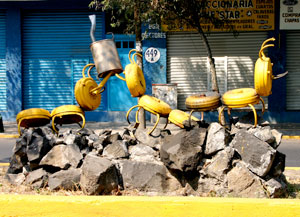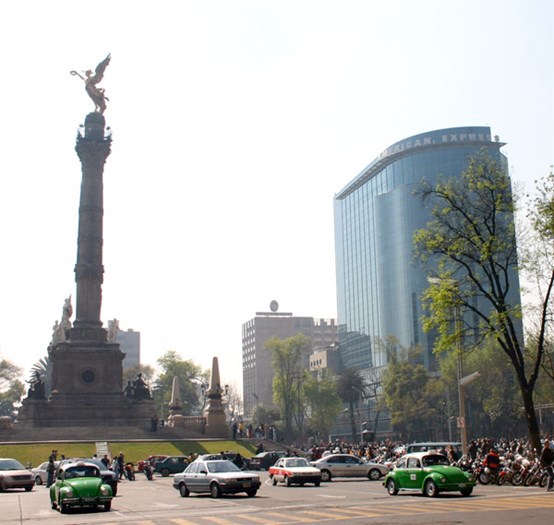MEXICO CITY - When you only have a few hours to visit the world’s largest city, you don’t stop in any one spot for very long. That was the dilemma I faced the day I met up with Juan, the man who had been assigned to show me Mexico’s ancient capital.
“We can not cover very much seignior in the time you have given me,” said the delightful Juan. “It will take us a few hours just to get to downtown from the airport.”
The roadway leading from the airport, where bleachers are set up so the locals can watch planes land, was choked with cars and a heavy smog hung over the roadway. I feared my ambitious plans for a whirlwind tour of old Mexico City before heading to the nearby resort town of Cuernavaca were in jeopardy.
“I will take this exit,” said Juan as he crossed two lanes of traffic and dashed up a ramp leading to a local neighborhood on Dr. Gomez Santos St. No sooner had we stopped at a traffic light when grubby looking men began approaching our car with engine parts, batteries and windshield wipers in their hands.
“These people are auto parts dealers and this is the way they sell theirs parts,” said Juan as he waved the men away. In the middle of the street was some brightly painted sculptures, which, to my amazement, were created from old auto parts.
“These people are very creative seignior,” said Juan. “They are very good artists – very bad mechanics.”
Juan pointed the car in the direction of the Centro Historico, the city’s 10-square-kilometre historic area that was designated a UNESCO World Heritage Site in 1988.
“This route is longer but it will be faster than the motorway,” said my driver as he sped through neglected neighborhoods where over 20 million (some say the number is closer to 25 million) people live huddled mostly in poverty.
It wasn’t always this way in Mexico City. This was once the envy of the ancient world. A place where Aztec kings ruled over what was then known as Tenochtitlan, the 14th century capital of Mexico’s legendary native people.
Juan jockeyed for position along Lazaro Cardenas Blvd., with an army of little green and white Volkswagen Beetle cabs that are the city’s transportation symbol. The cabs are a great way to get around the city and charge less than $12 an hour for a tour.
The streets closest to the Centro Historico are lined with classic colonial buildings, massive statues honoring the country’s fallen heroes and impressive churches built over 300 years ago - between the time of the Spanish Conquest (1521) and Mexico’s independence from Spain in (1821).


Left: The street art comes in many forms in Mexico City. Right: The Angel Statue on Paseo de la Reforma marks Mexico’s independence.
Soon we arrived at the city’s famed Plaza de la Constitucion, Mexico’s main square and the world’s second largest next to Moscow’s Red Square.
“The square is known as the Zocalo to local people,” said Juan. “Every city in Mexico has a Zocalo.”
The square is an amazing collection of historic buildings, including the city’s great cathedral, city hall and the National Palace. On the northeast corner of the Zocalo, a Spanish word meaning pedestal, there’s a brass model of the old Aztec capital that is truly fascinating. The plaza is also where the Halls of Montezuma once stood.
The Cathedral is the centerpiece of the Zocalo. Construction of the massive structure began in 1567 and it took almost 250 years to complete. Because it took so long it displays a mélange of architectural styles, including Gothic, baroque and neoclassical.
The Palacio Nactional was built from the ruins of an Aztec temple and was the former palace of Montezuma. Cortes also had his headquarters here.
Because the Zocalo was crowded with people, Juan decided we should return to our car because “we are running out of time seignior and there is still much to see.”
However, the portly Juan did take time to have a taco at a stand just off the main square.
“There are over 7,000 taco stands in the city,” said Juan who looked like he’d eaten at all of them. As Juan ate, I noticed a sea of people pouring out of a subway entrance.
“Be careful,” warned Juan as I started towards the entrance. “There are many banditos in our subway.”
Mexico City’s subway is not the safest or cleanest in the world, which explains why so few people use it, even though it charges the equivalent of 10 cents a ride. That’s a shame because, as I discovered when I poked my head inside the subway entrance, the walls are covered in Aztec art and some wonderful murals.
We were now stuck in one of Mexico’s infamous traffic jams, with the Plaza Garibaldi, our next stop, just around the corner. The plaza is where some of the city’s most impressive museums are located, including the National Palace, one dedicated to Jose Luis Guevas, the National Museum of Art and the Diego Rivera Museum.
Juan decided a pass by “is all we’ll have time for” because he wanted to show me the treasures along Paseo de la Reforma, Mexico City’s most impressive boulevard.
The street is lined with glass bank towers, luxury hotels, palatial residences, embassies and lots of statues, the most impressive of which is the Angel Statue, which commemorates Mexico’s independence from Spain.
The Paseo de la Reforma was built by Emperor Maximilian during Austria’s three-year reign of Mexico – between 1864 and 1867 – and was modeled after Brussels’s main avenue, Louise.
At the intersection of Reforma and Juarez, Juan tells me this is where bull fights were staged over 100 years ago.
Just off Paseo de la Reforma, one finds Mexico City’s only castle, Chapultepec Castle, the former imperial home of Emperor Maximilian. The castle occupies 2,100 acres of prime downtown real estate and is now home of the National Museum of History.
The pristine castle grounds are now a gathering place of Mexicans who like to visit its playgrounds, zoos and fine restaurants. A network of jogging trails also snakes through the park.
A few miles past the Castle, we came upon a series of modern buildings which form the University of Mexico, the oldest university in the western hemisphere and where tuition costs just $1 a month.
The campus landmark is its library, whose walls are covered with mosaic murals from Juan O’Gorman, the well known architect. Opposite the library is the old Olympic Stadium featuring mosaic murals by Diego Rivera.
“I think we have run out of time seignior,” Juan informed me. “We must get to Cuernavaca before it gets dark. Maybe one day you will come back and spend a longer time in our beautiful city.”
A few hours are defiantly not long enough to see all this beauty’s charms.